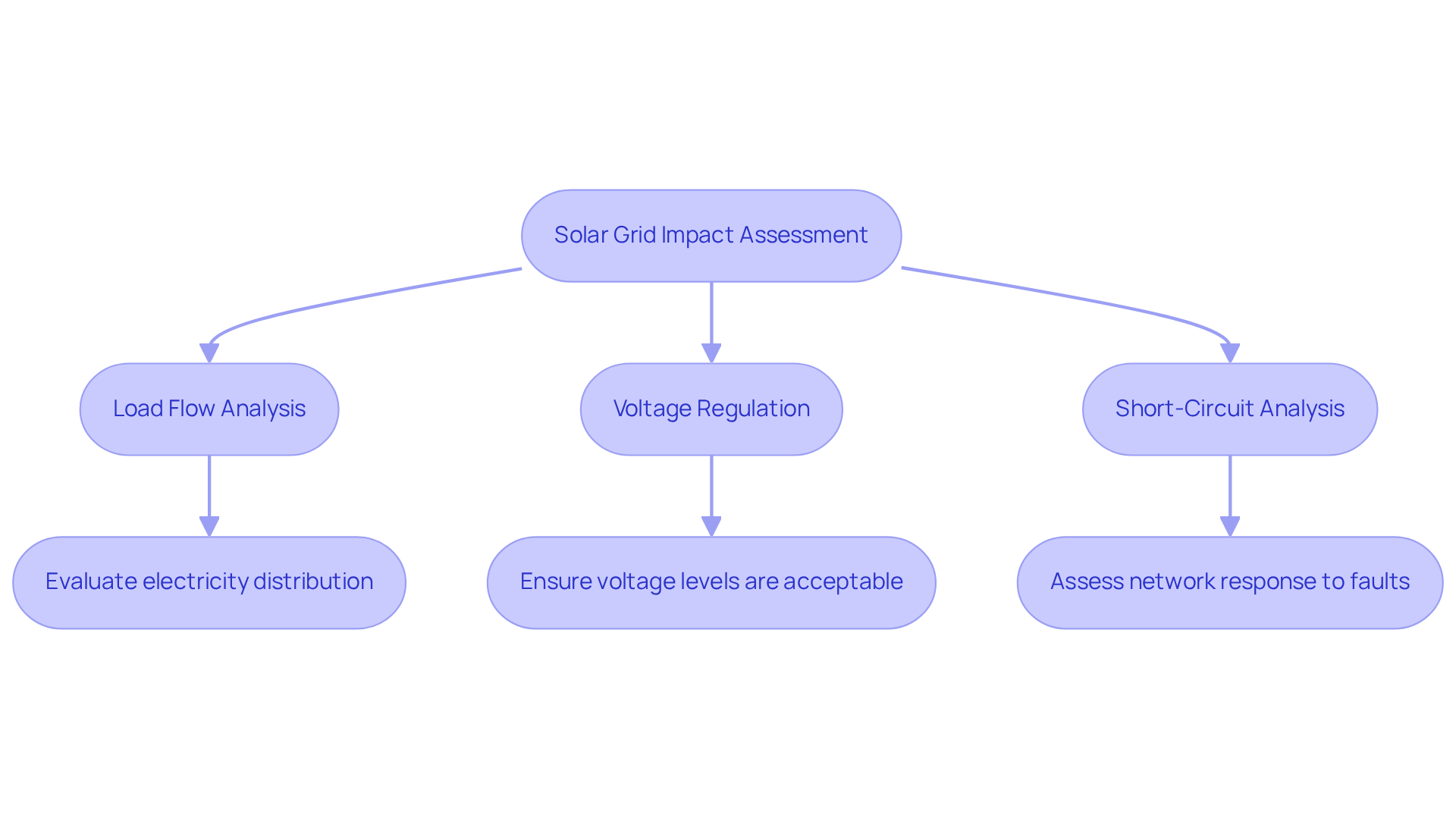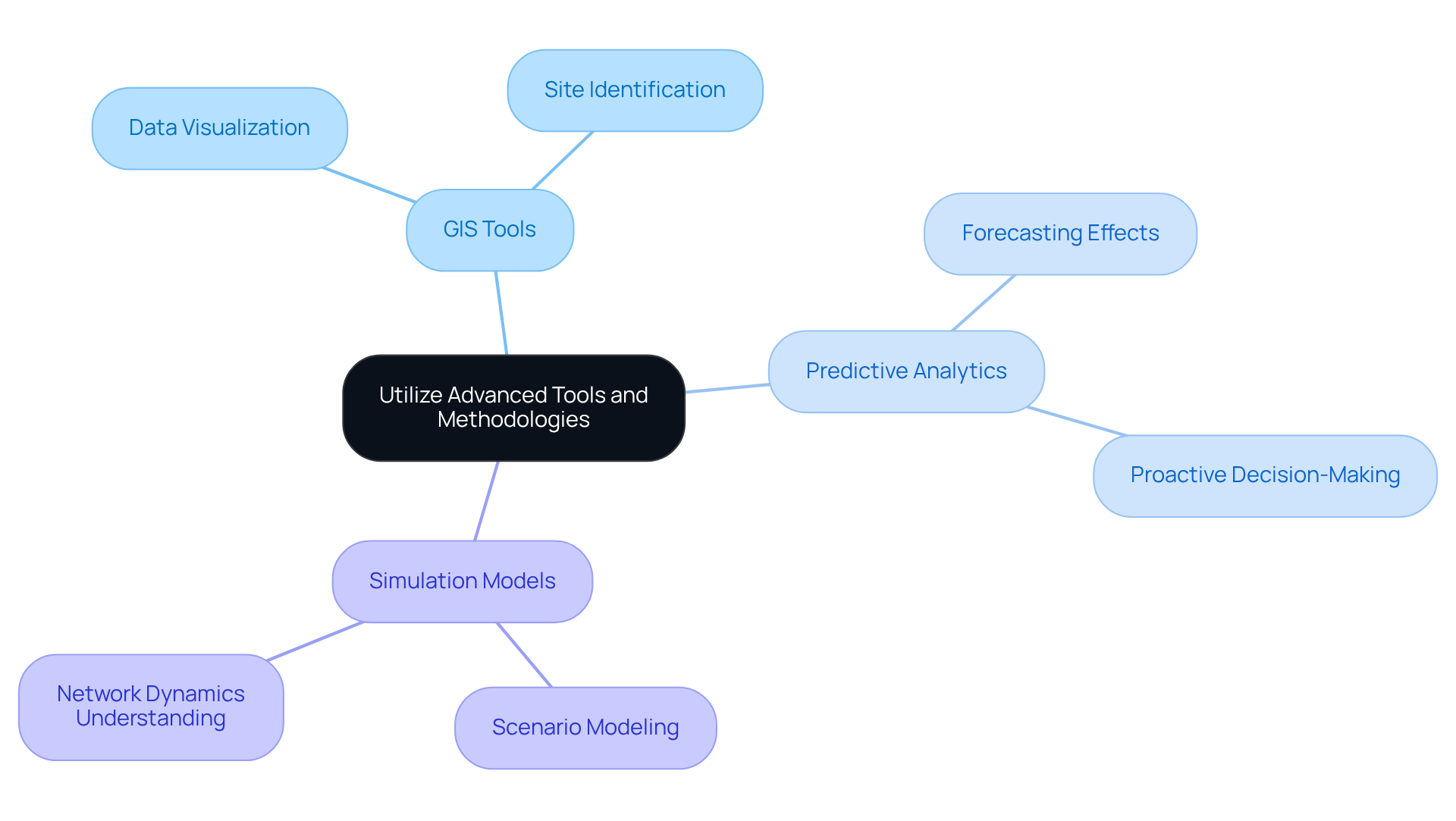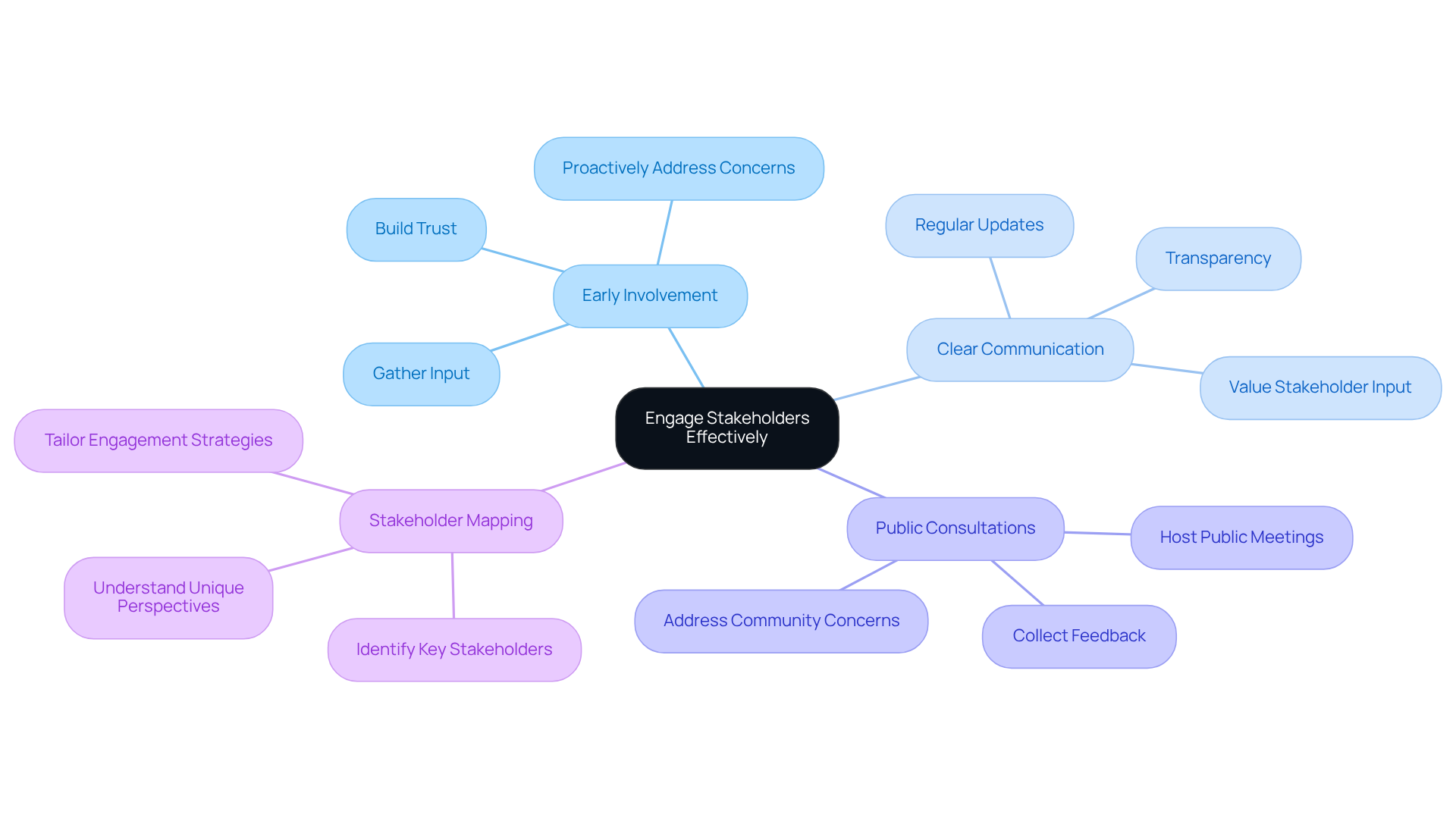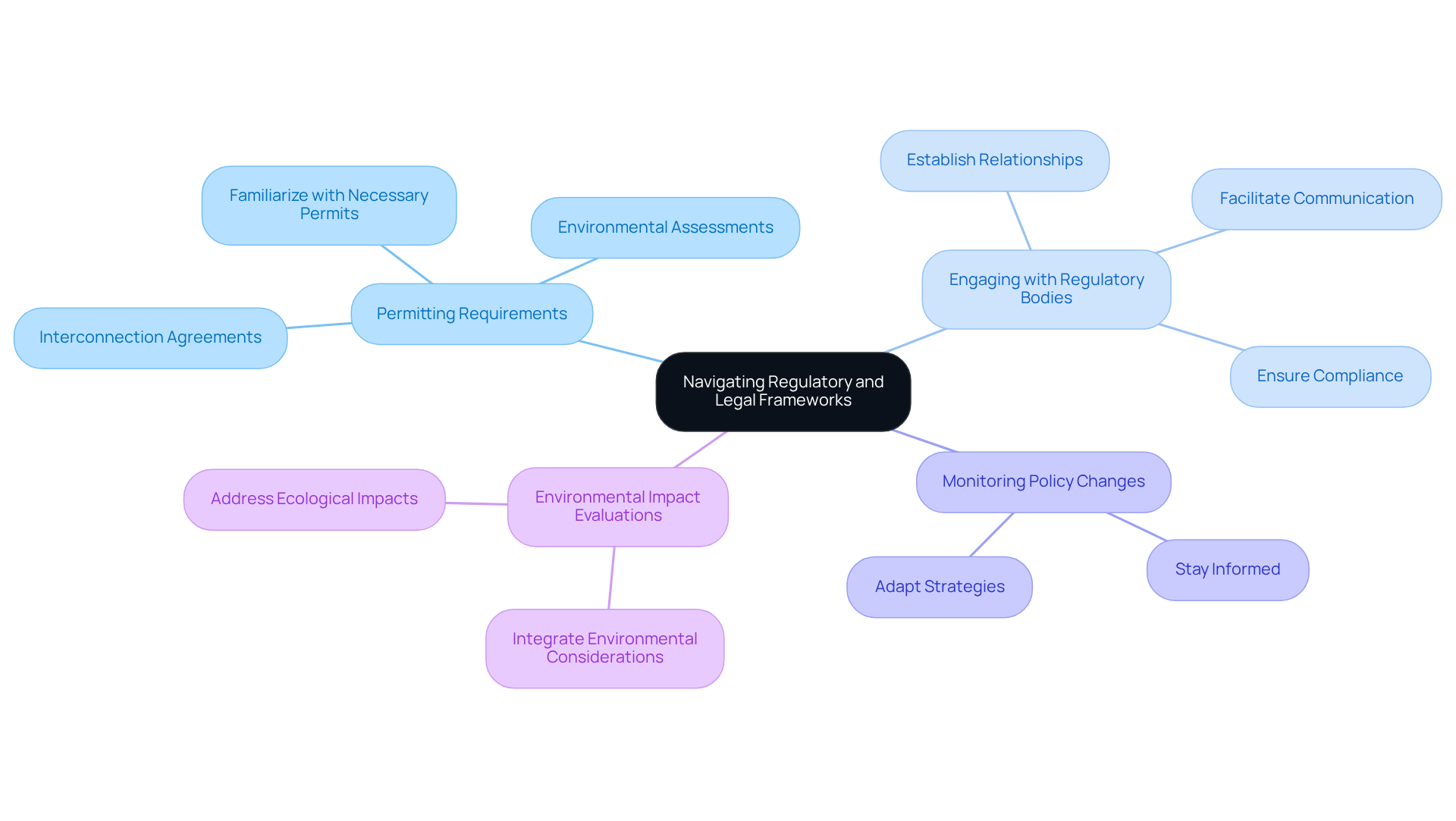Overview
The article presents four essential strategies for conducting regional solar grid impact assessments, highlighting the critical need for thorough evaluations, advanced tools, stakeholder engagement, and adept navigation of regulatory frameworks. These strategies are underpinned by discussions on:
- Load flow analysis
- The application of GIS technology
- Effective communication with stakeholders
- A comprehensive understanding of regulatory requirements
Each element is vital for the successful integration of solar energy into existing grid systems, addressing the complexities of land acquisition and the associated legal and regulatory challenges.
Introduction
Regional solar grid impact assessments are crucial in shaping the future of renewable energy integration, ensuring the electricity grid remains stable and efficient in the face of increasing demands. By examining the nuances of load flow, voltage regulation, and fault response, stakeholders can identify both challenges and opportunities that arise from solar energy implementation. Yet, how can developers effectively navigate the complexities of these assessments while engaging diverse stakeholders and adhering to regulatory frameworks? This article explores four key strategies designed to enhance the impact of regional solar grid assessments, paving the way for successful renewable energy projects.
Understand Solar Grid Impact Assessments
Regional solar grid impact assessments are critical analyses that evaluate how the integration of renewable energy systems affects the stability, reliability, and efficiency of the electricity grid. These evaluations involve a thorough examination of voltage levels, load flow, and potential disruptions to existing infrastructure. Understanding these factors is vital for developers, as it helps identify potential challenges and opportunities in energy integration. By conducting comprehensive evaluations, stakeholders can ensure that regional solar grid impact assessments enhance network operations without compromising system dependability.
Key components of solar grid impact assessments include:
- Load Flow Analysis: This evaluates how solar energy generation influences the distribution of electricity across the grid.
- Voltage Regulation: This examines the impact of renewable generation on voltage levels, ensuring they remain within acceptable limits.
- Short-Circuit Analysis: This assesses the network's response to faults and how renewable energy integration may alter fault currents.
By grasping these elements, stakeholders can make informed decisions that bolster the overall effectiveness of renewable energy initiatives.

Utilize Advanced Tools and Methodologies
To conduct effective evaluations of renewable energy infrastructure impacts, regional solar grid impact assessments must utilize advanced tools and methodologies. Technologies such as Geographic Information Systems (GIS), predictive modeling software, and AI-driven analytics significantly enhance the assessment process. These tools offer several advantages:
- Data Visualization: GIS tools facilitate the visualization of spatial data, enabling easier identification of potential sites for solar installations and assessing their impact on the grid.
- Predictive Analytics: AI algorithms analyze historical data to forecast the potential effects of renewable energy production on network performance, thereby supporting proactive decision-making.
- Simulation Models: Advanced simulation tools can model various scenarios, aiding stakeholders in understanding how different configurations of energy installations will affect network dynamics.
Incorporating these technologies into the evaluation process allows developers to achieve more accurate outcomes in regional solar grid impact assessments, reduce evaluation time, and ultimately enhance the viability of renewable energy initiatives.

Engage Stakeholders Effectively
Effectively engaging stakeholders is a crucial element in the success of regional solar grid impact assessments. Stakeholders encompass local communities, regulatory agencies, utility companies, and environmental groups. To foster collaboration and ensure that all voices are acknowledged, consider the following strategies:
- Early Involvement: Engage stakeholders from the project's inception to gather input and proactively address concerns. This approach builds trust and enhances design by integrating community insights.
- Clear Communication: Maintain open channels of communication by providing regular updates on task developments and evaluation results. Transparency demystifies the process and reassures stakeholders that their input is valued.
- Public Consultations: Host public meetings to discuss the evaluation process, collect feedback, and address community concerns. These consultations are vital for understanding local sentiments and cultivating a sense of ownership among stakeholders.
- Stakeholder Mapping: Identify key stakeholders and their interests to tailor engagement strategies effectively. Understanding the unique perspectives and concerns of different groups allows for more targeted and meaningful interactions.
By emphasizing these engagement strategies, developers can cultivate trust, mitigate conflicts, and significantly enhance the overall success of regional solar grid impact assessments. As David Suzuki remarked, "Photovoltaic energy is going to be absolutely essential to meeting growing energy demands while staving off climate change," underscoring the critical role of effective stakeholder engagement in harnessing the potential of photovoltaic energy.

Navigate Regulatory and Legal Frameworks
Navigating the regulatory and legal structures related to energy grid impact evaluations is essential for success. Adherence to federal, state, and local regulations guarantees that initiatives satisfy legal obligations and reduce possible risks. Key considerations include:
- Understanding Permitting Requirements: Familiarize yourself with the necessary permits and approvals required for solar installations, including environmental assessments and interconnection agreements.
- Engaging with Regulatory Bodies: Establish relationships with relevant regulatory agencies to facilitate communication and ensure compliance with evolving regulations.
- Monitoring Policy Changes: Stay informed about alterations in energy policies and regulations that may affect solar initiatives, adapting strategies accordingly.
- Conducting Environmental Impact Evaluations: Ensure that environmental considerations are integrated into the evaluation process to address potential ecological impacts.
Leveraging Harbinger Land's expertise in site and right-of-way acquisitions can significantly streamline this process. Our team utilizes highly integrated GIS modeling services to negotiate and acquire the necessary leases and easements for distributed energy resource (DER) and infrastructure development. These GIS services improve regulatory navigation by offering detailed spatial analysis and visualization, which assists in recognizing potential compliance issues early in the lifecycle. This approach not only saves clients time and money but also enhances decision-making by providing comprehensive mapping and title research services. By effectively navigating these regulatory frameworks, project developers can enhance the likelihood of successful regional solar grid impact assessments and project approvals.

Conclusion
Regional solar grid impact assessments are critical for the successful integration of renewable energy systems into existing electricity grids. By thoroughly analyzing factors such as voltage levels, load flow, and potential infrastructural disruptions, stakeholders can identify both challenges and opportunities arising from renewable energy integration. This understanding is essential to ensure that solar initiatives enhance grid stability and reliability while maximizing efficiency.
Key strategies for conducting effective assessments have been emphasized throughout the article. The use of advanced tools like Geographic Information Systems (GIS) and predictive analytics significantly enhances the accuracy and efficiency of evaluations. Engaging stakeholders early in the process not only fosters collaboration and trust but also ensures compliance and mitigates risks by navigating regulatory and legal frameworks. Each of these strategies plays a vital role in optimizing the integration of solar energy into regional grids.
In conclusion, the implementation of robust solar grid impact assessments is crucial for advancing renewable energy initiatives. By adopting best practices and effectively engaging stakeholders, developers can create a sustainable energy future that meets growing demands while minimizing environmental impacts. The time to act is now—embracing these strategies not only enhances project viability but also contributes to a cleaner, more resilient energy landscape.
Frequently Asked Questions
What are solar grid impact assessments?
Solar grid impact assessments are critical analyses that evaluate how the integration of renewable energy systems affects the stability, reliability, and efficiency of the electricity grid.
Why are solar grid impact assessments important?
They help identify potential challenges and opportunities in energy integration, ensuring that regional solar initiatives enhance network operations without compromising system dependability.
What key components are included in solar grid impact assessments?
Key components include Load Flow Analysis, Voltage Regulation, and Short-Circuit Analysis.
What is Load Flow Analysis?
Load Flow Analysis evaluates how solar energy generation influences the distribution of electricity across the grid.
What does Voltage Regulation examine?
Voltage Regulation examines the impact of renewable generation on voltage levels, ensuring they remain within acceptable limits.
What is the purpose of Short-Circuit Analysis?
Short-Circuit Analysis assesses the network's response to faults and how renewable energy integration may alter fault currents.
How do solar grid impact assessments benefit stakeholders?
By understanding the key components of these assessments, stakeholders can make informed decisions that bolster the overall effectiveness of renewable energy initiatives.
List of Sources
- Engage Stakeholders Effectively
- 60 Quotes About the Future of Renewable Energy (https://deliberatedirections.com/renewable-energy-quotes)
- 100 Quotes About Sustainability and ESG [2025] (https://digitaldefynd.com/IQ/inspirational-quotes-about-sustainability)
- Quotes About Solar Power: 50 Picks to Light Up Your Life - Lumify Energy (https://lumifyenergy.com/blog/quotes-about-solar-power)
- 20 Quotes To Get You Inspired For a Renewable Future - Solstice (https://solstice.us/solstice-blog/20-quotes-for-a-renewable-future)
- 100+ inspirational and powerful quotes on Sustainability (clustered by topic) - Twenty Now (https://twentynow.com/sustainability-initiatives/sustainability/100-inspirational-and-powerful-quotes-on-sustainability-clustered-by-topic)




